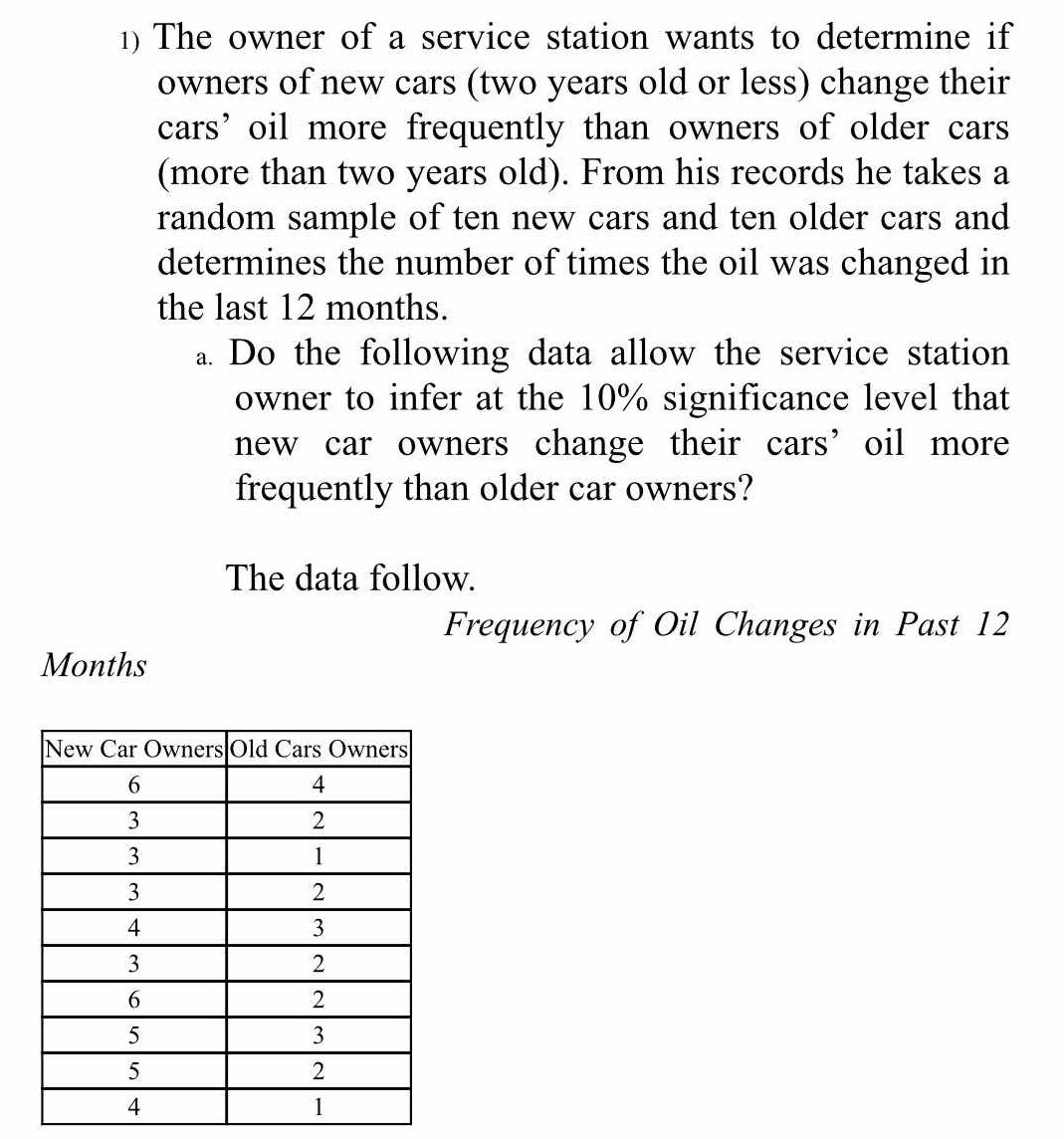Do the following data allow the service station owner to infer at the 10% significance level that new car owners change their cars' oil more frequently than older car owners? New... Do the following data allow the service station owner to infer at the 10% significance level that new car owners change their cars' oil more frequently than older car owners? New Car Owners: 6, 3, 3, 3, 4, 3, 6, 5, 5, 4 Old Car Owners: 4, 2, 1, 2, 3, 2, 2, 3, 2, 1

Understand the Problem
The question asks whether the provided data allows a service station owner to infer, at a 10% significance level, that owners of new cars change their oil more frequently than owners of older cars, based on the frequency of oil changes in the past 12 months for a sample of new and old cars.
Answer
Yes, the data allow the service station owner to infer at the 10% significance level that new car owners change their cars' oil more frequently than older car owners because $t = 4.117 > t_{critical} = 1.337$.
Answer for screen readers
Yes, the data allow the service station owner to infer at the 10% significance level that new car owners change their cars' oil more frequently than older car owners.
Steps to Solve
-
State the null and alternative hypotheses.
- Null hypothesis ($H_0$): New car owners change oil with the same frequency as older car owners. $\mu_{new} = \mu_{old}$
- Alternative hypothesis ($H_1$): New car owners change oil more frequently than older car owners. $\mu_{new} > \mu_{old}$ (right-tailed test)
-
Calculate the means for both samples. $$ \bar{x}{new} = \frac{6+3+3+3+4+3+6+5+5+4}{10} = \frac{42}{10} = 4.2 $$ $$ \bar{x}{old} = \frac{4+2+1+2+3+2+2+3+2+1}{10} = \frac{22}{10} = 2.2 $$
-
Calculate the standard deviations for both samples. $$ s_{new} = \sqrt{\frac{\sum_{i=1}^{10} (x_i - \bar{x}_{new})^2}{n-1}} $$ $$ = \sqrt{\frac{(6-4.2)^2 + (3-4.2)^2 + (3-4.2)^2 + (3-4.2)^2 + (4-4.2)^2 + (3-4.2)^2 + (6-4.2)^2 + (5-4.2)^2 + (5-4.2)^2 + (4-4.2)^2}{10-1}} $$ $$ = \sqrt{\frac{3.24 + 1.44 + 1.44 + 1.44 + 0.04 + 1.44 + 3.24 + 0.64 + 0.64 + 0.04}{9}} $$ $$ = \sqrt{\frac{13.6}{9}} \approx \sqrt{1.511} \approx 1.23 $$
$$ s_{old} = \sqrt{\frac{\sum_{i=1}^{10} (x_i - \bar{x}_{old})^2}{n-1}} $$ $$ = \sqrt{\frac{(4-2.2)^2 + (2-2.2)^2 + (1-2.2)^2 + (2-2.2)^2 + (3-2.2)^2 + (2-2.2)^2 + (2-2.2)^2 + (3-2.2)^2 + (2-2.2)^2 + (1-2.2)^2}{10-1}} $$ $$ = \sqrt{\frac{3.24 + 0.04 + 1.44 + 0.04 + 0.64 + 0.04 + 0.04 + 0.64 + 0.04 + 1.44}{9}} $$ $$ = \sqrt{\frac{7.6}{9}} \approx \sqrt{0.844} \approx 0.92 $$
-
Calculate the t-statistic using the independent samples t-test formula (assuming unequal variances): $$ t = \frac{(\bar{x}{new} - \bar{x}{old}) - (\mu_{new} - \mu_{old})}{\sqrt{\frac{s_{new}^2}{n_{new}} + \frac{s_{old}^2}{n_{old}}}} $$ Since we assume $\mu_{new} - \mu_{old} = 0$ under the null hypothesis: $$ t = \frac{4.2 - 2.2}{\sqrt{\frac{1.23^2}{10} + \frac{0.92^2}{10}}} $$ $$ t = \frac{2}{\sqrt{\frac{1.5129}{10} + \frac{0.8464}{10}}} $$ $$ t = \frac{2}{\sqrt{0.15129 + 0.08464}} = \frac{2}{\sqrt{0.23593}} \approx \frac{2}{0.4857} \approx 4.117 $$
-
Determine the degrees of freedom. Since we are not assuming equal variances, we use the Welch-Satterthwaite equation for approximating df: $$ df \approx \frac{\left(\frac{s_{new}^2}{n_{new}} + \frac{s_{old}^2}{n_{old}}\right)^2}{\frac{\left(\frac{s_{new}^2}{n_{new}}\right)^2}{n_{new}-1} + \frac{\left(\frac{s_{old}^2}{n_{old}}\right)^2}{n_{old}-1}} $$
$$ df \approx \frac{\left(\frac{1.5129}{10} + \frac{0.8464}{10}\right)^2}{\frac{\left(\frac{1.5129}{10}\right)^2}{10-1} + \frac{\left(\frac{0.8464}{10}\right)^2}{10-1}} $$
$$ df \approx \frac{(0.15129 + 0.08464)^2}{\frac{(0.15129)^2}{9} + \frac{(0.08464)^2}{9}} $$
$$ df \approx \frac{(0.23593)^2}{\frac{0.0228886441}{9} + \frac{0.0071649296}{9}} $$
$$ df \approx \frac{0.05566}{0.002543 + 0.000796} = \frac{0.05566}{0.003339} \approx 16.66 $$ Therefore, $df \approx 16$ (rounding down to the nearest integer).
-
Find the critical t-value. For a one-tailed (right-tailed) t-test with $\alpha = 0.10$ and $df = 16$, the critical t-value, $t_{critical}$, is approximately 1.337.
-
Compare the calculated t-statistic to the critical t-value. Since $t = 4.117 > t_{critical} = 1.337$, we reject the null hypothesis.
-
Conclusion:
At the 10% significance level, there is sufficient evidence to conclude that new car owners change their oil more frequently than older car owners.
Yes, the data allow the service station owner to infer at the 10% significance level that new car owners change their cars' oil more frequently than older car owners.
More Information
The t-test is a statistical test that is used to compare the means of two groups. In this case, the two are the mean of the number of oil changes for new car owners and the mean of the number of oil changes for older car owners. The significance level is the probability of rejecting the null hypothesis when it's actually true.
Tips
A common mistake would be using a paired t-test instead of an independent samples t-test. A paired t-test is used when the data is related (e.g., measuring the same subject twice), while an independent samples t-test is used when the data is from two separate, unrelated groups. In this problem, the samples of new and old car owners are independent, so using a paired t-test would be incorrect.
Another common mistake is assuming equal variances without testing for it. This can lead to incorrect degrees of freedom and, consequently, an incorrect p-value or critical value.
AI-generated content may contain errors. Please verify critical information